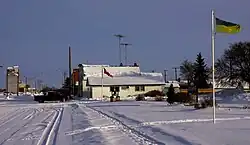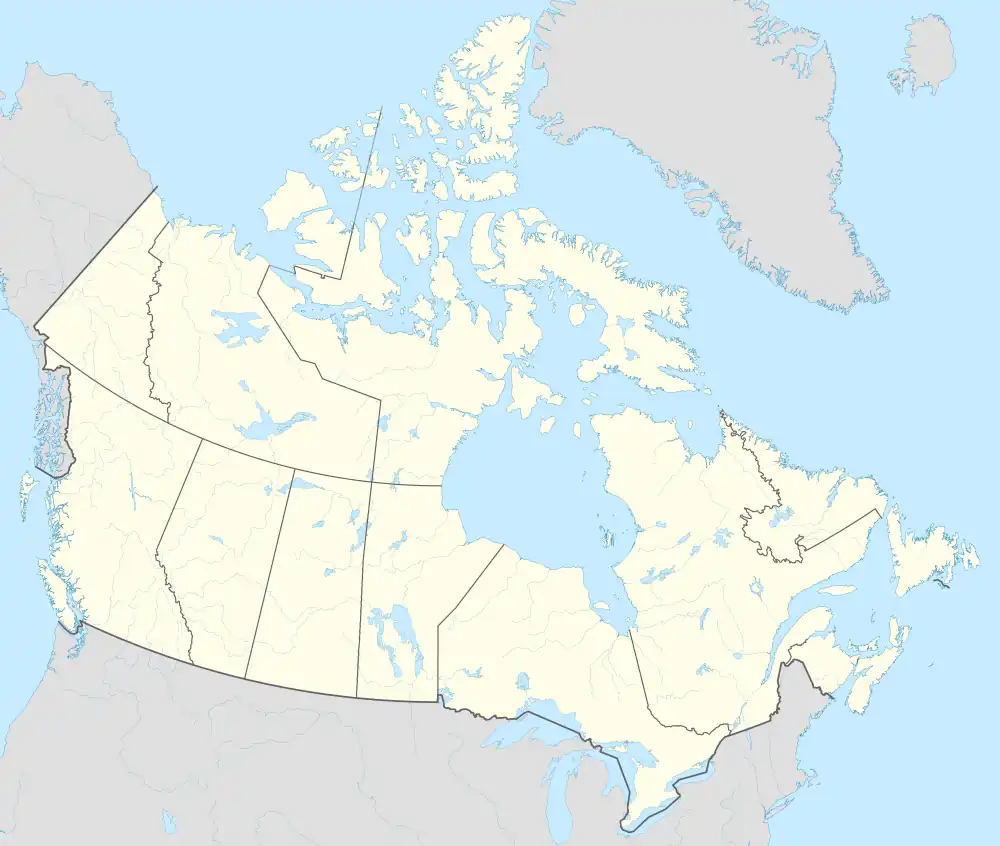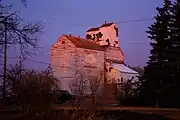Gainsborough | |
|---|---|
| Village of Gainsborough | |
 2011 image from viewpoint of 1978 painting "40 Below Zero" by William G. Hobbs. | |
| Motto: First incorporated village in Saskatchewan | |
 Gainsborough  Gainsborough | |
| Coordinates: 49°10′34″N 101°27′30″W / 49.17611°N 101.45833°W | |
| Country | |
| Province | |
| Region | Southeast |
| Census division | 1 |
| Rural Municipality | Argyle No. 1 |
| Post office Founded | 1884-04-01 |
| Incorporated (Village) | 1882 (1st. incorporated village in Saskatchewan) |
| Government | |
| • Type | Municipal |
| • Governing body | Gainsborough Village Council |
| • Mayor | Victor Huish |
| • Administrator | Erin McMillen |
| • MP | Robert Kitchen |
| • MLA | Dan D'Autremont |
| Area | |
| • Total | 1.95 km2 (0.75 sq mi) |
| Population (2016) | |
| • Total | 286 |
| Time zone | UTC-6 (CST) |
| Postal code | S0C 0Z0 |
| Area code | 306 |
| Highways | |
| Railways | Canadian Pacific Railway |
Gainsborough (2016 population: 254) is a village in the Canadian province of Saskatchewan within the Rural Municipality of Argyle No. 1 and Census Division No. 1. A farming community, the village is located on Highway 18 in the southeastern corner of Saskatchewan. Gainsborough is approximately 6 km (3.7 mi) from the Manitoba border, and 19 km (12 mi) from the North Dakota, United States border. The first post office was established on April 1, 1884[1] as the community of Antler. On September 1, 1885, the name of the community changed to Gainsborough,[2] after Gainsborough, Lincolnshire in England, which was the former home of J. J. Sadler, an early settler.[3]

Location
8 miles east is the community of Pierson, Manitoba. To the west 8 miles is the village of Carievale. 16 miles straight north of Gainsborough is the hamlet of Fertile. The closest communities to the south are Antler and Sherwood, North Dakota. Nearby towns to the north and west are Storthoaks, Carnduff, Glen Ewen, Oxbow, and Bellegarde, while to the east are Lyleton, Tilston and Melita, Manitoba. The nearest population centres with more than 10,000 people are approximately an hour's drive away: Estevan, which is westward on Highway 18, and Minot, North Dakota is a 75-minute drive almost directly south. Brandon is a 2-hour drive away, while Regina, Saskatchewan and Winnipeg are each approximately 3.0-3.5 hours away by car.
Antler is the closest border crossing station between Canada and the US, and like most small posts on the frontier it is closed overnight. Gainsborough is approximately equidistant to two 24-hour border crossings: North Portal, Saskatchewan 90 km to the west, and Boissevain, Manitoba 120 km to the east.
History
Gainsborough incorporated as a village on May 25, 1894.[4]
The Gainsborough Creek forms most of the southern boundary of the town, while the rest of the community is bordered by open fields and pasture. A tributary of the Souris River, the creek is prone to flooding during the spring thaw. Though several nearby communities made national headlines as disaster areas during severe flooding in 2011, most buildings in Gainsborough did not require unusual extraordinary protection measures or sandbagging. In 2014, extended heavy rainfall in the region resulted in severe flash flooding that forced the complete evacuation of residents to neighbouring communities and made national headlines.[5][6][7][8] Provincial premier Brad Wall did an aerial survey of the flood area that allowed images and video of the flooded village to be recorded near the maximum height of the waters.[9][10]
Demographics
In the 2021 Census of Population conducted by Statistics Canada, Gainsborough had a population of 227 living in 113 of its 144 total private dwellings, a change of -10.6% from its 2016 population of 254. With a land area of 0.94 km2 (0.36 sq mi), it had a population density of 241.5/km2 (625.5/sq mi) in 2021.[13]
In the 2016 Census of Population, the Village of Gainsborough recorded a population of 254 living in 124 of its 144 total private dwellings, a -14.6% change from its 2011 population of 291. With a land area of 0.87 km2 (0.34 sq mi), it had a population density of 292.0/km2 (756.2/sq mi) in 2016.[14]
Economy
Saskatchewan is in the CST Zone, and since 1967 it has not observed daylight saving time meaning that local clocks do not get changed in summer. A practical effect on border towns like Gainsborough is that they only align with neighbouring communities in Manitoba and North Dakota for half the year, which may lead to misunderstandings regarding the timing of scheduled inter-community events.
Primary income of community members is derived from agricultural businesses (farming, ranching) and petroleum drilling services.
Places of interest
- Bennet Park - located on Railway Avenue (main street), formerly the location of a pool hall, hardware store, and mechanic
- Bowens Park - central to the southern half of the town along Antler Avenue
- Memorial Cenotaph - located adjacent to the theatre on Bruce Street
- Churches - two (Knox United, Anglican). The Anglican Christ Church is registered on the List of historic places in Saskatchewan
- Community hall - basement with kitchen, main hall has a stage and upper meeting room
- Gainsborough Agricultural Grounds - kitchen facilities, three baseball diamonds, racetrack located north of the curling rink.
- Campground facilities are located north of the Health Centre adjacent to the sports fields.
- There is a privately owned museum with articles from the town's history that is opened by request.
Amenities, associations, and clubs
- Lions Clubs International
- Gainsborough Library
- Gainsborough Curling Club
- There is a small grass airstrip located in the north end of the town listed as the Gainsborough Airport.
Notable people
- Dr William G. Hobbs, a former physician in the Gainsborough Union Hospital (closed c. 1987), did a painting of the main street of the town entitled "40 Below Zero" that won a national contest in 1978. The buildings pictured in it are no longer standing and the location on Railway Avenue is now known as Bennett Park.
- Lew Morrison, former NHLer
- Richard Widdifield, Canadian Artist, Born in Gainsborough in 1961
- Dick Southam, former Progressive Conservative Member of Parliament.
Gallery
 Bennett Park
Bennett Park Gainsborough Welcome Sign
Gainsborough Welcome Sign As of 2012, the former Saskatchewan Wheat Pool building is the last standing grain elevator in the village.
As of 2012, the former Saskatchewan Wheat Pool building is the last standing grain elevator in the village.
See also
References
- ↑ "Item: 7347". Library and Archives Canada. Retrieved December 28, 2020.
- ↑ "Post Offices and Postmasters database". Library and Archives Canada. Archived from the original on November 19, 2011. Retrieved February 22, 2011.
- ↑ Geographic Board of Canada (1933). Place-names of Manitoba. Ottawa: J. O. Patenaude, acting King's printer. p. 37. hdl:2027/mdp.39015027929515. Retrieved October 11, 2017.
- ↑ "Urban Municipality Incorporations". Saskatchewan Ministry of Government Relations. Archived from the original on October 15, 2014. Retrieved June 1, 2020.
- ↑ "Village of Gainsborough evacuated". CJME. Retrieved February 22, 2015.
- ↑ "Flooding, highway closures as heavy rain pounds Prairies". Global News Canadian Press. Retrieved February 22, 2015.
- ↑ "Gainsborough still reeling after floods (video)". CBC News. Retrieved February 22, 2015.
- ↑ "CTV News (video)". CTV News. Retrieved February 22, 2015.
- ↑ "Photos: Saskatchewan, after the flood". Leader Post. Retrieved February 22, 2015.
- ↑ "Rain ruins farms and homes in flooding - Video (@0:24)". Leader Post. Archived from the original on February 23, 2015. Retrieved February 22, 2015.
- ↑ "Saskatchewan Census Population" (PDF). Saskatchewan Bureau of Statistics. Archived from the original (PDF) on September 24, 2015. Retrieved May 31, 2020.
- ↑ "Saskatchewan Census Population". Saskatchewan Bureau of Statistics. Retrieved May 31, 2020.
- ↑ "Population and dwelling counts: Canada, provinces and territories, census divisions and census subdivisions (municipalities), Saskatchewan". Statistics Canada. February 9, 2022. Retrieved April 1, 2022.
- ↑ "Population and dwelling counts, for Canada, provinces and territories, and census subdivisions (municipalities), 2016 and 2011 censuses – 100% data (Saskatchewan)". Statistics Canada. February 8, 2017. Retrieved May 30, 2020.
External links
 Media related to Gainsborough, Saskatchewan at Wikimedia Commons
Media related to Gainsborough, Saskatchewan at Wikimedia Commons.svg.png.webp) Canada portal
Canada portal
